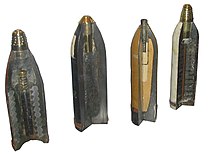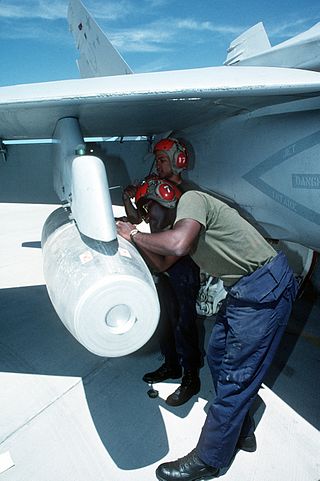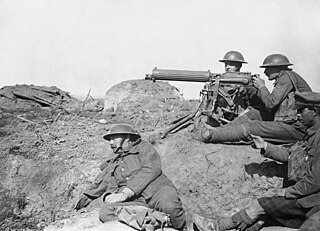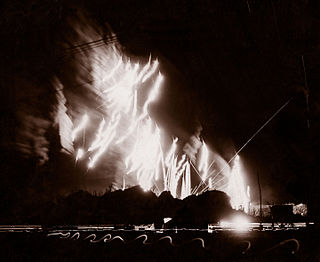
Incendiary ammunition is a type of ammunition that contains a chemical that, upon hitting a hard obstacle, has the characteristic of causing fire/setting flammable materials in the vicinity of the impact on fire.

Incendiary ammunition is a type of ammunition that contains a chemical that, upon hitting a hard obstacle, has the characteristic of causing fire/setting flammable materials in the vicinity of the impact on fire.

The first time incendiary ammunition was widely used was in World War I, more specifically in 1916. At the time, phosphorus was the primary ingredient in the incendiary charge and ignited upon firing, leaving a trail of blue smoke. These early forms were also known as "smoke tracers" because of this. Though deadly, the effective range of these bullets was only 350 yards (320 m), as the phosphorus charge burned quickly. [1] Incendiary bullets called "Buckingham" ammunition were supplied to early British night fighters for use against military zeppelins threatening the British Isles. The flammable hydrogen gas of the zeppelins made incendiary bullets much more deadly than standard ones which would pass through the outer skin without igniting the gas. Similarly, incendiary ammunition was used against non-rigid observation balloons. [2] The British Royal Flying Corps forbade the use of incendiary ammunition for air-to-air combat with another airplane, as their use against personnel was at first considered to be a violation of the St. Petersburg Declaration. Pilots were permitted to deploy them against only zeppelins and balloons. Furthermore, they were required to carry written orders on their person when engaging these targets. [3]
During World War II, incendiary bullets found a new use: they became one of the preferred types of ammunition for use in interceptor fighters. They were not nearly as effective at puncturing bomber aircraft as armor-piercing bullets, but were far more effective than standard bullets because they could ignite fuel if they pierced a fuel tank or pipeline. [4]
Belgian inventor de Wilde, who was living in Switzerland, invented a new bullet in 1938. In December of that year the British Air Ministry purchased the design. However, as the bullet had to be made by hand rather than mass-produced, Major C. Aubrey Dixon of the British Royal Arsenal at Woolwich developed a greatly improved bullet with similar incendiary capabilities. [5] This was adopted by British forces as the 0.303 Incendiary B Mark VI. For security reasons, and to confuse the enemy, it was initially called 'de Wilde' ammunition, even though the design was almost entirely different from the original version. The B Mark VI incendiary bullet was packed with nitrocellulose, and a small steel ball was placed in the tip of the bullet to ensure that the chemical exploded on impact. As opposed to earlier designs, the B Mark VI was a true incendiary rather than tracer ammunition. [6] The B Mark VI incendiary bullets were first issued in June 1940 and tested operationally in the Hawker Hurricane and Supermarine Spitfire in the air battles over Dunkirk. The explosive power, coupled with the flash on impact which guided their aim, was much appreciated by pilots. The bullets were at first scarce, and as a result, a mix of ball, AP, Mk IV incendiary tracer and Mk VI incendiary were used until production increased to sufficient levels. By 1942 the standard loading for fixed .303s was half loaded with AP and half with incendiary bullets. [7]
An RAF fighter pilot who was shot down by incendiary ammunition in the Battle of Britain describes his experience: [8]
"I could smell powder smoke, hot and strong, but it didn't make me feel tough this time. It was from the cannon shells and incendiary bullets that had hit my machine...Bullets were going between my legs, and I remember seeing a bright flash of an incendiary bullet going past my leg into the gas tank...Then a little red tongue licked out inquiringly from under the gas tank in front of my feet and became a hot little bonfire in one corner of the cockpit."
Incendiary projectiles, in particular those intended for armor penetration, are more effective if they explode after penetrating a surface layer, such that they explode inside the target. Additionally, targets with onboard electronics or computers can be damaged by metal fragments when they explode on the surface. Ignition is often delayed by varying means until after impact. [9]
Some explosive projectiles, such as high-explosive incendiary bullets, contain an incendiary charge intended to ignite explosives within the shell. [9]
Although not intended to start fires, tracer bullets can have a mild incendiary effect. This is particularly dangerous when they strike flammable substances or dry brush.

A Molotov cocktail is a hand-thrown incendiary weapon consisting of a frangible container filled with flammable substances and equipped with a fuse. In use, the fuse attached to the container is lit and the weapon is thrown, shattering on impact. This ignites the flammable substances contained in the bottle and spreads flames as the fuel burns.

A bullet is a kinetic projectile, a component of firearm ammunition that is shot from a gun barrel. They are made of a variety of materials, such as copper, lead, steel, polymer, rubber and even wax; and are made in various shapes and constructions, including specialized functions such as hunting, target shooting, training, and combat. Bullets are often tapered, making them more aerodynamic. Bullet size is expressed by weight and diameter in both imperial and metric measurement systems. Bullets do not normally contain explosives but strike or damage the intended target by transferring kinetic energy upon impact and penetration.

Armour-piercing ammunition (AP) is a type of projectile designed to penetrate armour protection, most often including naval armour, body armour, vehicle armour.

The .50 BMG, also known as 12.7×99mm NATO, and designated as the 50 Browning by the C.I.P., is a .50 in (12.7 mm) caliber cartridge developed for the M2 Browning heavy machine gun in the late 1910s, entering official service in 1921. Under STANAG 4383, it is a standard service cartridge for NATO forces, as well as many non-NATO countries. The cartridge itself has been made in many variants: multiple generations of regular ball, tracer, armor-piercing (AP), incendiary, and saboted sub-caliber rounds. The rounds intended for machine guns are made into a continuous ammunition belt using metallic links.

An autocannon, automatic cannon or machine cannon is a fully automatic gun that is capable of rapid-firing large-caliber armour-piercing, explosive or incendiary shells, as opposed to the smaller-caliber kinetic projectiles (bullets) fired by a machine gun. Autocannons have a longer effective range and greater terminal performance than machine guns, due to the use of larger/heavier munitions, but are usually smaller than tank guns, howitzers, field guns, or other artillery. When used on its own, the word "autocannon" typically indicates a non-rotary weapon with a single barrel. When multiple rotating barrels are involved, such a weapon is referred to as a "rotary autocannon" or occasionally "rotary cannon", for short.

Incendiary weapons, incendiary devices, incendiary munitions, or incendiary bombs are weapons designed to start fires or destroy sensitive equipment using fire, using materials such as napalm, thermite, magnesium powder, chlorine trifluoride, or white phosphorus. Though colloquially often known as bombs, they are not explosives but in fact are designed to slow the process of chemical reactions and use ignition rather than detonation to start or maintain the reaction. Napalm, for example, is petroleum especially thickened with certain chemicals into a 'gel' to slow, but not stop, combustion, releasing energy over a longer time than an explosive device. In the case of napalm, the gel adheres to surfaces and resists suppression.

Technology during World War I (1914–1918) reflected a trend toward industrialism and the application of mass-production methods to weapons and to the technology of warfare in general. This trend began at least fifty years prior to World War I during the American Civil War of 1861–1865, and continued through many smaller conflicts in which soldiers and strategists tested new weapons.

A shell, in a military context, is a projectile whose payload contains an explosive, incendiary, or other chemical filling. Originally it was called a bombshell, but "shell" has come to be unambiguous in a military context. A shell can hold a tracer.

Tracer ammunition, or Tracers, are bullets or cannon-caliber projectiles that are built with a small pyrotechnic charge in their base. When fired, the pyrotechnic composition is ignited by the burning powder and burns very brightly, making the projectile trajectory visible to the naked eye during daylight, and very bright during nighttime firing. This allows the shooter to visually trace the trajectory of the projectile and thus make necessary ballistic corrections, without having to confirm projectile impacts and without even using the sights of the weapon. Tracer fire can also be used as a marking tool to signal other shooters to concentrate their fire on a particular target during battle.

A smoke screen is smoke released to mask the movement or location of military units such as infantry, tanks, aircraft, or ships.

The .303 British or 7.7×56mmR, is a .303-inch (7.7 mm) calibre rimmed tapered rifle cartridge. The .303 inch bore diameter is measured between rifling lands as is the common practice in Europe which follows the traditional black powder convention.

The MG FF was a drum-fed, blowback-operated, 20 mm aircraft autocannon, developed in 1936 by Ikaria Werke Berlin of Germany. It was a derivative of the Swiss Oerlikon FF F cannon, with the Oerlikon FF design itself a development of the Imperial German World War I Becker 20 mm cannon, and was designed to be used in space-limited, fixed mountings such as inside aircraft wings, although it saw use as both an offensive and a defensive weapon, in both fixed and flexible format. It saw widespread use in those roles by the German Luftwaffe, particularly during the early stages of World War II, although from 1941 onwards it was gradually replaced by the Mauser firm's 20 mm MG 151/20, which had both a higher rate of fire and muzzle velocity.

White phosphorus munitions are weapons that use one of the common allotropes of the chemical element phosphorus. White phosphorus is used in smoke, illumination, and incendiary munitions, and is commonly the burning element of tracer ammunition. Other common names for white phosphorus munitions include WP and the slang terms Willie Pete and Willie Peter, which are derived from William Peter, the World War II phonetic alphabet rendering of the letters WP. White phosphorus is pyrophoric ; burns fiercely; and can ignite cloth, fuel, ammunition, and other combustibles.
Fallujah, The Hidden Massacre is a documentary film by Sigfrido Ranucci and Maurizio Torrealta which first aired on Italy's RAI state television network on November 8, 2005. The film documents the use of chemical weapons, particularly the use of incendiary bombs containing white phosphorus, and alleges that insurgents and civilians, including children, had been killed or injured by chemical burns by military forces of the United States of America in the city of Fallujah in Iraq during the Fallujah Offensive of November 2004.

The Projector, 2.5 inch—more commonly known as the Northover Projector—was an ad hoc anti-tank weapon used by the British Army and Home Guard during the Second World War.

An air-to-air rocket or air interception rocket is an unguided projectile fired from aircraft to engage other flying targets. They were used briefly in World War I to engage enemy observation balloons and in and after World War II to engage enemy bombers. Fighters were too maneuverable to be effectively engaged with rockets.

Ammunition is the material fired, scattered, dropped, or detonated from any weapon or weapon system. Ammunition is both expendable weapons and the component parts of other weapons that create the effect on a target.
The Ranken Dart was an anti-Zeppelin weapon developed during the First World War. It was an air-dropped 1 lb (450 g) explosive flechette-type of missile-shaped bomb which was 13 inches (330 mm) long and 5.9 inches (150 mm) wide while being of a steel and wood construction.

The Gryazev-Shipunov GSh-30-1 is a 30 mm autocannon designed for use on Soviet and later Russian military aircraft, entering service in the early 1980s. Its current manufacturer is the Russian company JSC Izhmash. The name GSH-30-1 is formed from the surnames of the designers Gryazev (Грязев) and Shipunov (Шипунов), the caliber of 30 mm and the single-barrel design of the gun itself.

The Pomeroy bullet was designed by New Zealander John Pomeroy (1873–1950) as an anti-zeppelin weapon. Pomeroy bullets were supposed to explode when encountering the minimal resistance of fabric envelopes containing hydrogen gas holding the zeppelin aloft. The explosion might produce a larger hole in the fabric than the small diameter bullet and the energy of the explosion might ignite the hydrogen in the presence of atmospheric oxygen outside of the envelope.